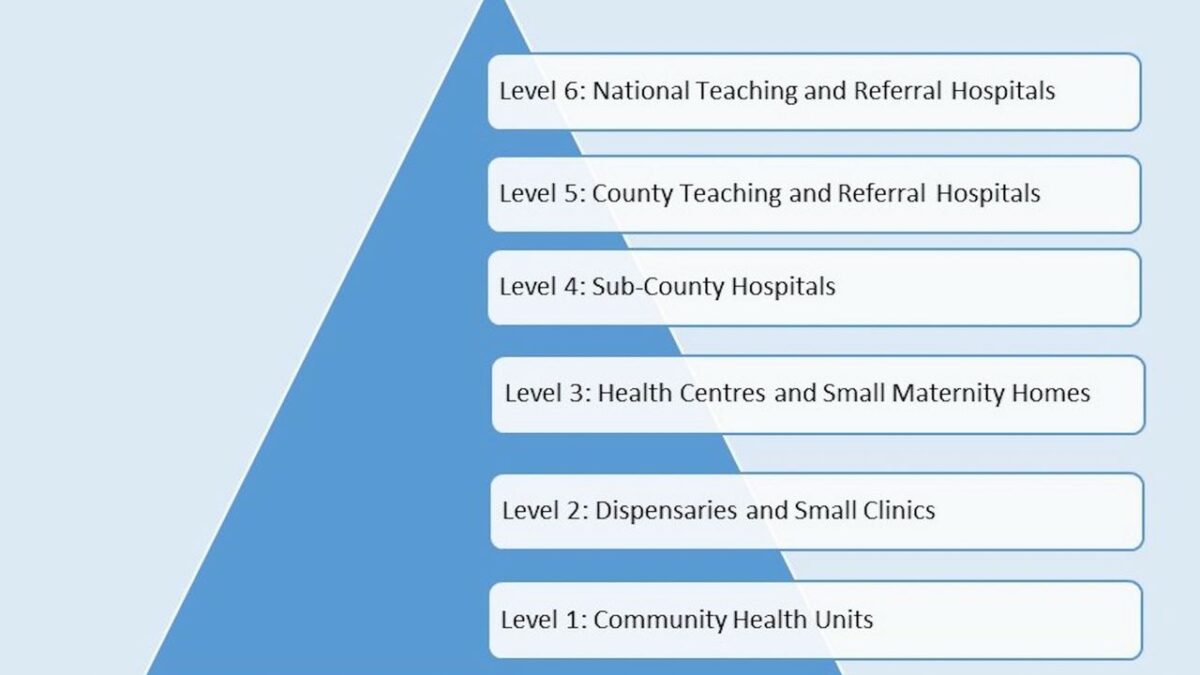Kenya’s Healthcare Tier System Explained

Image credit: BMJ Global Health
As we journeyed through the histories of our oldest health institutions in #KeHospitals, we came across the hospital tier system. When developing the stories, it is safe to say that the system left us with lingering questions. What exactly do the different hospital levels mean?
To tackle these questions, we came up with a handy guide to hospital levels.
Kenya’s Healthcare System
Health is one of the 14 devolved functions in the country managed by our 47 county governments. The Kenya Medical and Practitioners and Dentists Board is responsible for the classification of health facilities into levels. This detailed classification is determined by services offered, infrastructural capacity, and the human resources present at the hospital.
There are six different levels of health facilities and Referral letters allow a patient to move from one level to another. The first five are managed at the county level, by the Chief Executive Committee (CEC) while the Cabinet Secretary (CS) for health oversees the sixth at the national level.
Hospital Levels at the Grassroots
At the first level, we have community health units that are headed by certified medical clinical officers. They constitute teams recruited to offer communities preventive healthcare, basic sanitation services – like vaccination, childcare, first aid – and health education.
While community health units offer mainly preventive service, level two dispensaries and private clinics are the facilities we visit when we need basic outpatient services for common ailments. Led by registered nurses, they include Eye, Nose, and Throat (ENT) clinics, dentist clinics, mobile e-clinics, home-based care services, and even standalone funeral facilities.
More expanded services begin to appear at level three with health centres. These are small hospitals that run like big hospitals but have fewer facilities. Health Centres are divided into three sub-levels and are often run by at least one medical doctor supported by clinical officers, and nurses.
Level 3C is the foundational tier of this level as it is here that you’ll receive basic preventive and curative health and ambulance services. On progressing to level 3B, you’ll find help at general medical and dental clinics. And at level 3A you’ll receive comprehensive preventive, curative, and rehabilitative health, as well as maternity theatre services.
Medium-Sized Hospitals
At the constituency level and beyond, level four hospitals including sub-county hospitals, nursing homes, and medium-sized private hospitals are the mainstay. These are primary referral hospitals offering holistic services and one or more specialised services. In many counties, there is just one hospital, but in larger cities like Nairobi, there are two of this kind.
These hospitals are divided into three based on their services: level 4A, which are primary care hospitals that provide complementary health services for more comprehensive treatment, level 4B facilities that include specialist stand-alone medical centers, medical-surgical, diagnostic, and clinical laboratory centers, and level 4C specialist health clinics that offer one or more specialized services but are limited to diagnostic, outpatient, daycare, and consultancy services.
These hospitals are headed by a director who is a doctor by profession. Pumwani Maternity Hospital is one of 133 level 4 hospitals in the country.
Level 5 Hospitals
At the fifth level we have county referral hospitals – formerly known as provincial hospitals – alongside teaching and referral hospitals, and large private as well as faith-based hospitals. Level 5 hospitals are run by Chief Executive Officers who are medics by profession and have over 100 beds capacity for their in-patient units. They provide internship services for medical staff, and since they are usually affiliated with universities, conduct research and serve as training centres for paramedical professionals.
Gertrude’s Children’s Hospital, Mombasa Hospital, Jaramogi Oginga Odinga Teaching and Referral Hospital, Maua Methodist Hospital and Nairobi Hospital are but a few of Kenya’s 82 level 5 hospitals.
Hospitals at the National Level
Lastly, on the sixth and topmost level, are the national referral hospitals. Their range of services is the same as those found on Level 5, except that they offer specialised treatments to patients in Kenya and across East and Central Africa.
There are two types of these hospitals. Foremost is level 6a which constitutes national teaching and referral hospitals for level 5 institutions and below, while also serving as teaching and training centres for diploma, undergraduate, and postgraduate medical professionals. Kenyatta National Hospital is a great example of hospitals on this level.
Level 6b encompasses hospitals that offer specialised services or a group of them. They include oncological, radiological, dental, renal, and ophthalmologic institutions as well as large referral hospitals like Tenwek Mission Hospital, Mathari National Teaching and Referral Hospital, and the National Spinal Injury Referral Hospital.
Are you familiar with the different hospital levels? Let us know in the comments!



